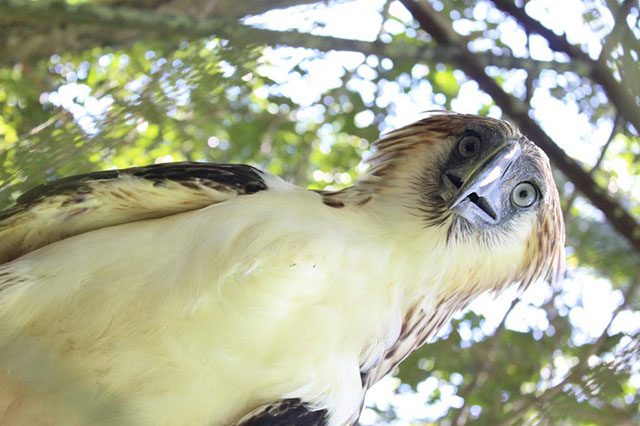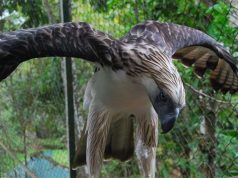A student from Colegio de San Juan de Letran appealed on Twitter to help spread awareness on conserving the Philippine Eagle, an endangered bird endemic to the Philippines.
Isiah Beltrano shared photos of the Philippine Eagle and captioned them with: “A national treasure. Let’s all work together and save the Philippine Eagle. Kung kinaya natin mag spread ng awareness sa Panda Bear ng China ano pa ba yung sariling atin.”
A national treasure. Lets all work together and save the Philippine Eagle. Kung kinaya natin mag spread ng awareness sa Panda Bear ng China ano pa ba yung sariling atin. pic.twitter.com/2jlod1VSD1
— Isiah Beltrano (@Isiahbeltrano) January 22, 2019
The Philippine Eagle, one of the largest eagles in the world, has a wingspan of two meters, is one meter tall and has distinct features of a massive beak, long crown feathers and blue eyes.
It was assessed as critically endangered by the International Union for Conservation of Nature in 2016. The report was published in 2018.
There are only approximately 180 to 500 mature birds, IUCN’s report said, and their numbers are rapidly dwindling over the years. They are only found on the rain forests of Luzon, Samar, Leyte and Mindanao.
One of those who commented on the post also called to protect the Philippine pangolins or balintong, another endangered creature that is endemic to the province of Palawan.
Can we also share the love for our very own Philippine Pangolins? They are the most illegally traded animal in the world yet most are unaware of their existence. Take a moment and just appreciate the beauty of this scaled mammal from Palawan. ❤️ pic.twitter.com/c10iGVjnmC
— Angelo Abao (@immatakeABAO) January 28, 2019
Assessment
The IUCN said that the decline is most likely due to the loss of its habitats over the last three generations.
“Forest destruction and fragmentation, through commercial timber extraction and shifting cultivation, is the principal long-term threat. Old-growth forest continues to be lost rapidly, such that as little as 9,220 km2 may remain within the eagle’s range. Moreover, most remaining lowland forest is leased to logging concessions,” the organization said.
It also considered the standing practice of hunting for the bird as another threat, particularly young or juvenile birds that are easily trapped and shot.
“Naive juvenile birds are easily shot or trapped, as are adults nesting near forest edges (J. Ibanez in litt. 2008). Birds are also vulnerable to accidental capture in traps intended for wild pigs and deer, and there are several records of individuals caught in snares presumably whilst hunting on the forest floor (J. Ibanez in litt. 2008),” the IUCN said.
In 2015, the death of a Philippine Eagle named Pamana in Davao City caught the attention made international news headlines.
Pamana was shot only two months after it was released to Mount Hamiguitan, a UNESCO World Heritage Site, following three years of treatment at the Philippine Eagle Foundation.
Despite the existence of conservation and environmental laws, the IUCN found in-place research and monitoring in the country’s conservation actions lacking.
Why should it be protected?
The Philippine Eagle, also known as the monkey-eating eagle, was declared the Philippine’s national bird by virtue of Proclamation 615 in 1995.
The Philippine Eagle Foundation, an organization that rescues and treats these feathered raptors, emphasized that the extinction of the species meant losing a unique part of Philippine heritage.
“It is found nowhere else except in the Philippines where it is the country’s national bird. Losing the species to extinction would also mean losing a nation’s precious biological heritage,” the PEF said.
The group also said that being a predator, the Philippine eagle plays an important role in keeping the ecosystem balanced. Furthermore, Filipino communities near their habitats will also benefit in eco-tourism and the natural resources that forests provide.
“Additionally, a healthy forest helps control soil erosion, mitigate the effects of climate change, minimize flooding, and provides additional sources of food, medicine, clothing, and shelter for our people” it explained.
Aside from PEF, there’s also an ordinance filed that seeks to declare Mount Mingan in Central Luzon as a Critical Habitat for the Philippine Eagle.
The trade of the Philippine Eagle is generally prohibited across countries according to the Convention on International Trade of Endangered Species or CITES.
Such provision is also stated in the Wildlife Resources Conservation and Protection Act wherein “No person or entity shall be allowed possession of wildlife unless such person or entity can prove financial and technical capability and facility to maintain said wildlife.”









